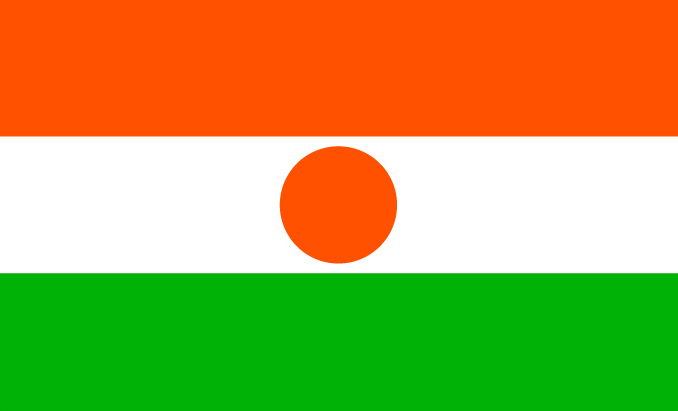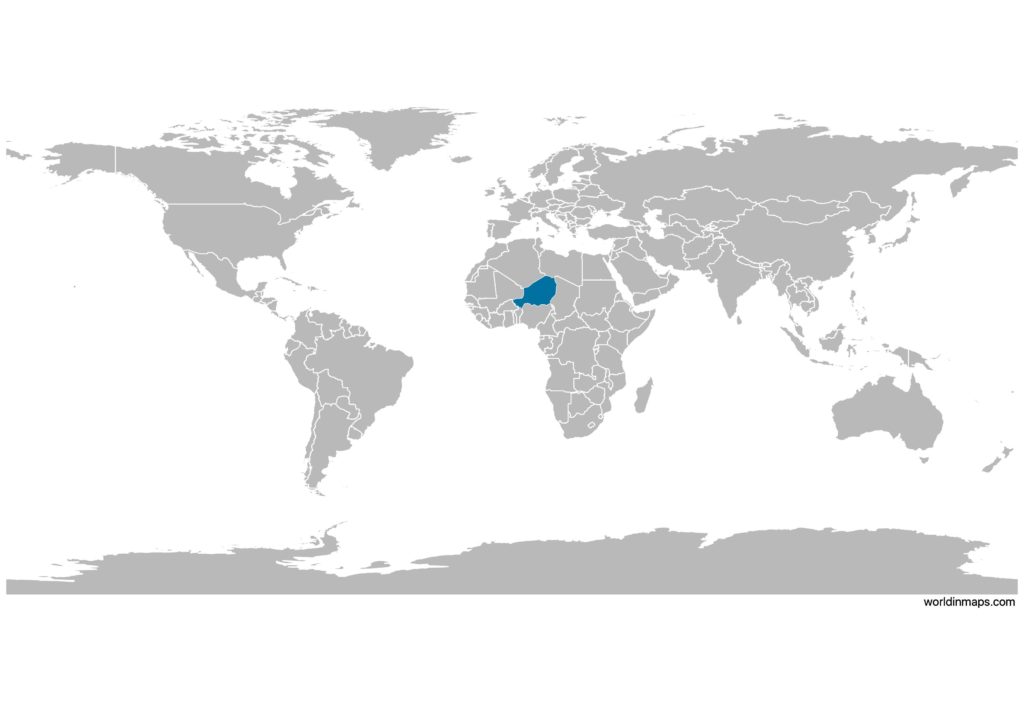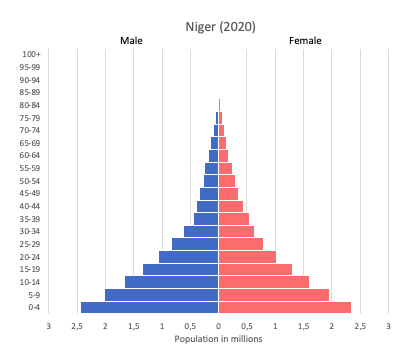Niger

| Government | |
| Name | Republic of the Niger |
| French | République du Niger |
| Government type | semi-presidential republic |
| Capital | Niamey (978,029 (2012)) |
| Currency | West African CFA franc (XOF) |
| People | |
| Population (2020) | 24,206,636 (57th) |
| Density of population | 12.1 P/km2 |
| Nationality | Nigerien |
| Official languages | |
| French | |
| Ethnic groups (2006) | |
| Hausa | 53.1% |
| Zarma / Songhai | 21.2% |
| Tuareg | 11% |
| Fulani (Peuhl) | 6.5% |
| Kanuri | 5.9% |
| Gurma | 0.8% |
| Arab | 0.4% |
| Tubu | 0.4% |
| other / unavailable | 0.9% |
| Religions (2012) | |
| Muslim | 99.3% |
| Christian | 0.3% |
| animist | 0.2% |
| none | 0.1% |
| Life expectancy (2020) | |
| Male | 57.8 years |
| Female | 60.8 years |
| Total population | 59.3 years (219th) |
| Homicides | |
| Total (2012) | 4.4 per 100,000 people (68th) |
| Geography | |
| Land area | 1,266,700 km2 |
| water area | 300 km2 |
| total area | 1,267,000 km2 (23rd) |
| Mean elevation | 474 m |
| Lowest point | |
| Niger River | 200 m |
| Highest point | |
| Idoukal-n-Taghes | 2,022 m |
| Land use (2011) | |
| Agricultural land | 35.1% |
| Arable land | 12.3% |
| Permanent crops | 0.1% |
| Permanent pasture | 22.7% |
| Forest | 1% |
| Other | 63.9% |
| Urbanization | |
| Urban population (2020) | 16.6% |
| Rate of urbanization | 4.27% annual rate of change (2015 – 2020) |
| Economy | |
| Labor force (2017) | 6.5 million (70th) |
| Labor force by occupation (2012) | |
| Agriculture | 79.2% |
| Industry | 3.3% |
| Services | 17.5% |
| Unemployment rate (2017) | 0.3% (3rd) |
| GDP (PPP) (estimate 2018) | |
| Total | $23.475 billion (140th) |
| Per capita | $1,213 (183rd) |
| GDP (nominal) (estimate 2018) | |
| Total | $9.869 billion (136th) |
| Per capita | $510 (179th) |
| GDP by sector (estimate 2017) | |
| Agriculture | 41.6% |
| Industry | 19.5% |
| Services | 38.7% |
| Exports (2017) | $4.143 billion (115th) |
| Exports partners (2017) | |
| France | 30.2% |
| Thailand | 18.3% |
| Malaysia | 9.9% |
| Nigeria | 8.3% |
| Mali | 5% |
| Switzerland | 4.9% |
| Imports (2017) | $1.829 billion (171st) |
| Imports partners (2017) | |
| France | 28.8% |
| China | 14.4% |
| Malaysia | 5.7% |
| Nigeria | 5.4% |
| Thailand | 5.3% |
| US | 5.1% |
| India | 4.9% |
Niger on the world map

Niger top 10 largest cities (2012)
- Niamey (978,029)
- Maradi (267,249)
- Zinder (235,605)
- Tahoua (117,826)
- Agadez (110,497)
- Arlit (78,651)
- Birni-N’Konni (63,169)
- Dosso (58,671)
- Gaya (45,465)
- Tessaoua (43,409)
Demography
Population pyramid

Age structure data
Estimate for 2020:
- 0-14 years: 50.58% (male 5,805,102/female 5,713,815)
- 15-24 years: 19.99% (male 2,246,670/female 2,306,285)
- 25-54 years: 23.57% (male 2,582,123/female 2,784,464)
- 55-64 years: 3.17% (male 357,832/female 364,774)
- 65 years and over: 2.68% (male 293,430/female 317,866)
Remark: the age structure of a population affects a nation’s key socioeconomic issues. Countries with young populations (high percentage under age 15) need to invest more in schools, while countries with older populations (high percentage ages 65 and over) need to invest more in the health sector. The age structure can also be used to help predict potential political issues. For example, the rapid growth of a young adult population unable to find employment can lead to unrest.
Population from 1950 to 2020
Source: United Nations, Department of Economic and Social Affairs, Population Division (2019). World Population Prospects 2019, Online Edition. Rev. 1.
Evolution of the life expectancy from 1960 to 2018
Source: World Development Indicators, The World Bank
Major rivers
Economy
Agriculture:
cowpeas, cotton, peanuts, millet, sorghum, cassava (manioc, tapioca), rice, cattle, sheep, goats, camels, donkeys, horses, poultry
Industries:
uranium mining, petroleum, cement, brick, soap, textiles, food processing, chemicals, slaughterhouses
Exports – commodities:
uranium ore, livestock, cowpeas, onions
Imports – commodities:
foodstuffs, machinery, vehicles and parts, petroleum, cereals
Time zone and current time in Niger
Go to our interactive map to get the current time in Niger